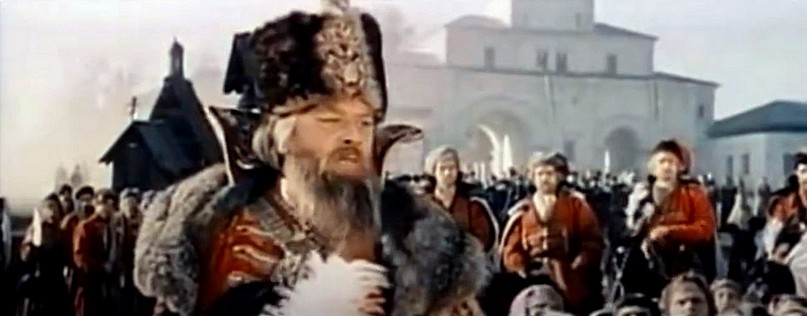Screen: ‘Khovanschina’:Mussorgsky Opera Is Offered at Cameo
By A.h. Weiler • Sept. 19, 1960
OUT of the murky and bloody pages of Russian history so dear to the hearts of the Soviet film-makers, the Mosfilm Studio has fashioned a fiercely nationalistic, gloomy, yet resplendent, picturization in fine colors and appropriate wide-screen of Mussorgsky’s opera «Khovanschina.»But, like its sources, the musical drama, which came to the Cameo on Saturday and was considered by most authorities as unfinished at the composer’s death, still appears to be slightly segmented, rough and opaque to the untutored eye of the amateur beholder. This despite Shostakovich’s orchestration and help on the film script and ample English subtitles. On the Cameo’s screen the beauty, power and music of «Khovanschina’s» parts are clearer and more impressive than the whole.Since the late seventeenth-century period on which Mussorgsky based his text was confused and near-chaotic, it is understandable that a dramatization of events in a Moscow riven by religious schisms, court intrigue and military and political power putsches would not be simple to stage or screen flowingly and lucidly. This «Khovanschina» is neither, but its strength is evident in the direction of Vera Stroyeva, who also collaborated on the script, in effectively using masses of people in choral groups and, occasionally, in individual scenes.A viewer may be confused as to the power plays of the boyars, led by Prince Ivan and his son; the machinations of the suspicious Prince Golitsyn; the cries of doom of the religious leader Dosipheir and his followers, and the landless, wandering peasantry voicing both doubt and hope. But Miss Stroyeva’s cast is striking physically and vocally, and is able, now and again, to project effectively the drama of violently changing times.The opening scene of the Moscow boyars’ tough soldiers, the Strelski, awakening to the sounds of bells is colorful and sonorous. Scenes of Moscow at dawn and dusk, with campfires lighting the river banks; a revel in the boyar’s palace with the noted ballerina Maya Plisetskaya as the soloist, and a political clash of the nobles in Prince Golitsyn’s palace are memorably reflective of the rough-hewn mores and culture of an awakening Russia.Suffice it to say that the performances, both physical and vocal, are a credit to operatic, if not accepted screen, style. It is obvious that these are robust and superbly trained voices. This is especially notable in the outstanding bass renditions of Mark Reizen, as Dosiphei, the Dissenter, and of the performances of Alexei Krivchenya, as Prince Khovansky; Kira Leonova, as the decorative, ill-fated Marfa, and Vladimir Petrov, as the handsome Prince Golitsyn.»Khovanschina» rarely has been sung here, since it first was staged by the Metropolitan Opera company in 1950. But, if the Mosfilm company and Miss Stroyeva, who previously filmed Mussorgsky’s «Boris Gudonov,» have not come up with a «Khovanschina» impressive enough to cause the Met to change its schedules, they at least have given us a closer, more colorful view of an uneven work that deserves respect and some attention.
The Cast KHOVANSCHINA; Screen play by Dmitri Shostakovich, Anna Abramova and Vera Stroyeva; from the opera by Mussorgsky; directed by Miss Stroyeva; a Mosfilm production presented here by Artkino with English subtitles.
At the Cameo Theatre. Eighth Avenue and Forty-fourth Street 17 September 1960 (New York City, New York). Running time: 130 minutes.
Dosiphel . . . . . Mark Reizen
Prince Ivan Khovansky . . . . . Alexei Krivchenya
Prince Vassily Golitsyn . . . . . Vladimir Petrov
Anton Grigoriev Boyar Shaklovity . . . . . Yevgeni Kibkalo
Marfa . . . . . Kira Leonova
Kuzka . . . . . Alexei Maslennikov
Peasant Leader . . . . . Victor Nechipailo
Persian Dancer . . . . . Maya Plisetskayaandthe soloists, chorus, corps de ballet and orchestra of the Bolshoi Theatre.

Выпущен на экран 14 ноября 1959 года.
Первый советский широкоэкранный фильм-опера.
Выпущен на экран в Венгрии 2 июня 1960 года
Выпущен на экран в США 17 сентября 1960 года.
Выпущен на экран в Аргентине 5 октября 1960 года
Выпущен на экран в Дании 27 марта 1966 года.
| ФИЛЬМОГРАФИЯ ОТЕЧЕСТВЕННЫХ ФИЛЬМОВ |



